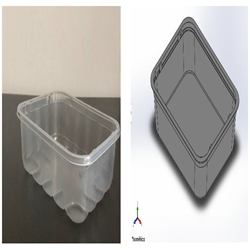Globally, the advancement of science and technology has increased demand for natural resources. Concerns have been raised about environmental conservation and natural resource scarcity. Additionally, the depletion of oil reserves, the greenhouse effect, and the widespread use of non-biodegradable materials have prompted researchers to investigate new biodegradable, renewable, and recyclable materials. Polylactide (PLA) has been suggested as a viable alternative to synthetic plastics derived from petroleum by-products. PLA is a renewable and biodegradable plastic made from agricultural products such as sugar beet and corn. It possesses high mechanical strength and stiffness, and its composites can be manufactured using conventional manufacturing techniques. PLA is an excellent material for fabricating biodegradable composites. PLA's inherent properties enable it to stand alone. PLA is brittle in nature due to its low thermal stability, low crystallisation rate, low impact resistance, and low impact resistance. PLA's inherent characteristics and properties make it an attractive candidate for use as a blend component or as a matrix material in composites. Nevertheless, due to minimal glass transition temperature, poor thermal dimensional stability, as well as mechanical ductility, its scope of application is restricted.
In today's world, the relentless march of science and technology has propelled an ever-increasing demand for natural resources on a global scale. As a result, concerns have arisen regarding environmental conservation and the looming spectre of natural resource scarcity. This pressing issue is further exacerbated by the depletion of oil reserves, the ominous greenhouse effect, and the pervasive use of non-biodegradable materials. In response to these challenges, researchers have embarked on a quest to unearth novel biodegradable, renewable, and recyclable materials that can mitigate the environmental impact of our technological progress.
One of the promising contenders in this arena is Polylactide (PLA). Derived from agricultural products such as sugar beet and corn, PLA stands as a renewable and biodegradable plastic endowed with remarkable mechanical strength and stiffness. Moreover, PLA-based composites can be crafted using traditional manufacturing techniques, making it a formidable candidate to produce biodegradable composites. While PLA possesses inherent properties that enable it to function independently, it does have certain limitations. These include brittleness, low thermal stability, a sluggish crystallization rate, and subpar impact resistance.
Nevertheless, the unique characteristics of PLA render it an attractive choice for incorporation as either a blend component or a matrix material in composite materials. Despite its merits, PLA's scope of application remains constrained due to factors like a minimal glass transition temperature, inadequate thermal dimensional stability, and limited mechanical ductility.
In the pursuit of eco-friendly alternatives, biodegradable food packaging has emerged as a beacon of hope. This packaging is crafted from materials capable of breaking down, decomposing, and seamlessly assimilating into the environment. Its primary objective is to curtail the detrimental environmental repercussions associated with conventional non-degradable packaging materials, most notably plastic. Plant-based materials represent exemplary instances of such biodegradable food packaging materials.
Notably, the quest for sustainability has led to the exploration of sugar cane and corn as viable feedstocks to produce biodegradable and compostable plastics. As the demand for sustainable and environmentally friendly products continues to surge, it is highly likely that the production of biobased plastics from crops like sugar cane and corn will experience sustained growth, not only in Malaysia but also in other nations across Asia.
Innovations in materials science have also introduced nanoclay into the surface, a minuscule clay particle typically on the nanoscale, measuring less than 100 nanometers in size. When synergistically combined with PLA, nanoclay orchestrates a transformation, enhancing the material's thermal stability, stiffness, and barrier properties. This dynamic improvement renders it exceptionally suitable for applications such as food packaging. However, it is imperative to recognize that while these modifications can augment PLA's properties, they may potentially influence its biodegradability. Consequently, additional research is indispensable to gain a comprehensive understanding of how these enhancements impact the material's behavior within the environmental ecosystem.
Considering these developments, a transformative project emerges with the aim of surmounting the compatibility challenges posed by PLA. This ambitious undertaking seeks to harness the potential of PLA-reinforced green nanocomposites food packaging, anticipated to usher in a new era characterized by heightened mechanical strength, reduced applied weight, and sustained biodegradability. Such advancements in the polymer nanocomposite industry are poised to be widely embraced, aligning seamlessly with the Sustainable Development Goals (SDG) for 2030 and the 12th Malaysia Plan. Consequently, these innovations will empower Malaysians to chart a course toward a more prosperous, sustainable, and inclusive future.
Adapted from Poster Presentation: Polylactide Based Green Nanocomposites in Food Packaging Applications:
Mohd Hafizuddin bin Ab Ghani, Ismayadi Ismail, Rosnah Nawang, Che Azurahanim Che Abdullah, Nishata Royan Rajendran Royan, Wan Nazri Wan Busu, Ruey Shan Chen, Mohd Nazry Salleh. Hyper Interdisciplinary Conference in Malaysia 2023, 18th February 2023, MRANTI Park, Kuala Lumpur.
https://hiconf.lne.st/conference/malaysia2023/
Date of Input: 27/09/2023 | Updated: 27/09/2023 | roslina_ar
MEDIA SHARING























